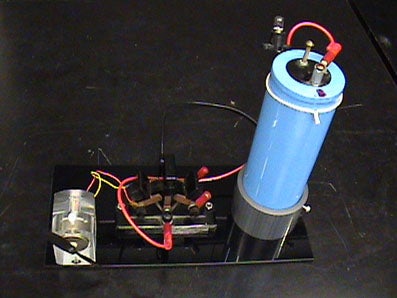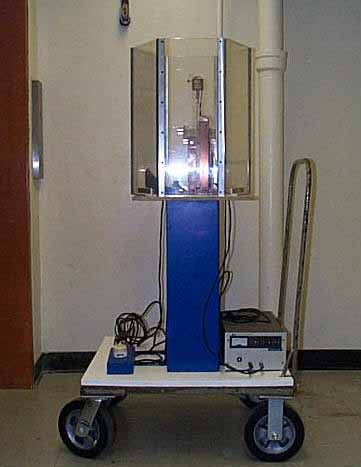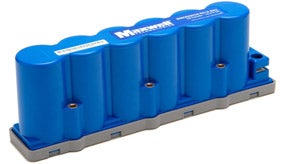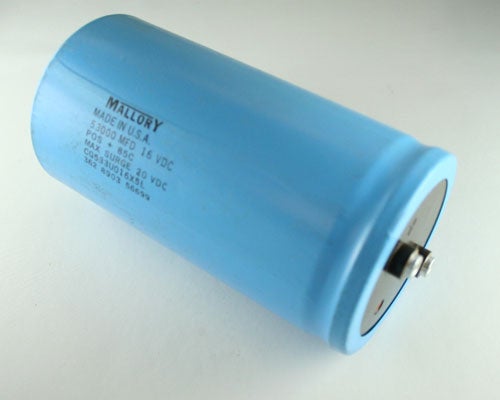-
Energy stored in a capacitor is used to drive a small motor that turns a propeller. The circuit consists of eight capacitors in parallel with equivalent capacitance of 30,000 microfarads connected in series with five 500 ohm resistors in series. The time constant for the circuit is 75 seconds. The apparatus is connected to a high voltage power supply set at 250 volts. it is set in a 25 cm x 25 cm board.

-
A capacitor (100 microfarad, 3000 V DC) is charged up for a few minutes. The capacitor is connected to a power supply. After it has been charged, turn the power off and the multimeter (Be careful when disconnecting the multimeter). The capacitor is then shorted with a big metal bar with insulated handle causing a big spark.
Click here to see a video of this demo.

-
A large capacitor (240 microfarads, 5000V) is used as the supporting stand for an arrangement that surprisingly shows the energy stored in a capacitor. Thick Plexiglas’s sheets are placed over it and around the set-up consisting of: an electromagnetic switch, a small meter, resistors and the stand that firmly holds a very thin metal wire, as shown in the figure. The power supply and a long wire switch are set by its side. The capacitor is charged up during 5-10 minutes at 2000 V DC through a resistor R=1.8 x 106 ohm (or until the meter indicates at least 15-20 minutes). Turn the power supply off. Take the switch and step away from the apparatus. Close and open the remote switch. When the circuit is closed, the capacitor will discharge through the thin wire pulverizing it. It causes a big blast, a big spark and even some smoke. The time constant for this circuit is 432 seconds. After being charged for 5 minutes, the charged accumulated on the capacitor is about 0.24 Coulomb and the total energy released on the instant of explosion is about 173 Joules. It is very loud and very surprising. Be aware that the capacitor might still be charged since the wire explosion usually does not discharge it completely. A discharger with long handles is used to do completely discharge the capacitor, followed by other smaller blasts and sparks.

-
This revised demo consists of: a large capacitor (240 microfarads; 5 kV), an electromagnetic switch, a small meter, and a stand that firmly holds a very thin metal wire, as seen through a Plexiglas shield. The power supply and a long wire switch are set by its side.
The capacitor is directly charged up to 3 kV DC for approximately 15 minutes. Afterwards, the charge accumulated on the capacitor is about 0.24 Coulombs and the total energy released upon short circuiting is about 173 Joules. When the circuit is closed, the capacitor will discharge through the thin wire, pulverizing it. This causes a loud blast and big sparks. Be aware that the capacitor might still be charged since the wire explosion usually does not discharge it completely. A discharger with long handles is used to completely discharge the capacitor.
Two types of wire can be used:
- Copper magnet wire
- Bare nickel-chromium wire
Click here to see a video of the new Wire Exploder demo in action.
-
This demo consists of one 16 V/58 F capacitors compared with one 16 V/210000 uF ultracapacitors. Each pair of capacitors is connected to an electric fan. As expected, the fan connected to the normal capacitors will stop after a few seconds while the fan connected to the ultracapacitors will last much longer. This demonstrates that ultracapacitors have the ability to store more charge than do normal capacitors.
Click here to see a video of this demo


Energy in a Capacitor
Contact our lab
Visit Us
USC Physics Lecture Support Lab SLH (Stauffer Lecture Hall) – 104
Department of Physics and Astronomy
University of Southern California
Los Angeles
Questions or Comments
If you have questions or comments e-mail us or call at phone number below.